فرانس دے شاہی حکمراناں دی لسٹ
| فرانسیسی شاہی حکمرانی Monarchy France | |
|---|---|
| سابقہ بادشاہت | |

| |
| Royal Coat of arms | |
| اولین بادشاہ/ملکہ | کلوویس اول (بطور بادشاہ) |
| آخری بادشاہ/ملکہ | نپولین سوم (بطور شہنشاہ) |
| انداز | ویکھو مضمون |
| سرکاری رہائش گاہ | کونسیغجیری لووغ محل ویغسائی محل تویلیغی محل |
| تقرر کنندہ | موروثی |
| بادشاہت دا آغاز | 486 |
| بادشاہت دا آختتام | 4 ستمبر 1870 |
| موجودہ مدعی | متنازع: Louis Alphonse (خاندان بوربن) Henri d'Orléans (خاندان اورلینز) Jean-Christophe (خاندان بوناپارٹ) |

ایہ لسٹ فرانسیسی شاہی حکمرانان (List of French monarchs) اے۔
فرانس دے بادشاہاں نے 843 وچ مغربی فرانک دی بادشاہت دے قیام توں لے کے 1870 وچ دوسری فرانسیسی سلطنت دے خاتمے تک کئی رکاوٹاں دے نال حکومت کیتی۔ سن 849 وچ کنگ چارلس بالڈ توں لے کے 1792 وچ کنگ لوئس XVI تک فرانس دے 45 بادشاہ سن ۔ فرانسیسی انقلاب دے بعد 7 شہنشاہاں تے کنگز نوں شامل کرنے توں ، ایہ گل فرانس دے کل 52 بادشاہاں دی اے۔
اگست 843 وچ معاہدہ ورڈن نے فرانک اقتدار نوں تن ریاستاں وچ ونڈ دتا ، جنہاں وچوں اک (مشرق فرانسیا) مختصر عرصے دا سی۔ ہور دو فرانس (مغربی فرانسیا) تے بالآخر جرمنی (مشرقی فرانسیا) وچ تبدیل ہوئے۔ اس وقت تک ، زمین دے مشرقی تے مغربی حصےآں وچ پہلے ہی مختلف زباناں تے ثقافتاں موجود سن۔
کیپٹین خاندان ، جو ہیو کیپٹ دی نسل دے فرزند نسل اے ، نے پہلے حکمراناں نوں شامل کيتا جس نے پہلی بار فلپ دوم (دور. 1180–1223) دے نال فرانس دے بادشاہ دا لقب اختیار کيتا۔ کیپٹینیاں نے 987 توں 1792 تک تے فیر 1814 توں 1848 تک مستقل حکمرانی کيتی۔ خاندان دیاں شاخاں جنہاں نے 1328 دے بعد حکمرانی کيتی ، عموما Val ویلوئس (1589 تک) تے بوربن (1589 توں) دے مخصوص شاخاں دے ناں دتے جاندے نيں۔
مختصر مدت دے دوران جدوں 1791 دا فرانسیسی آئین نافذ ہويا (1791–92) تے جولائی انقلاب دے بعد 1830 وچ ، "بادشاہ فرانس آف" (اور نوارے) دی بجائے "شاہ آف فرانسیسی" دا استعمال کيتا گیا۔ ایہ اک آئینی بدعت سی جسنوں مشہور بادشاہت کہیا جاندا اے ، جس نے بادشاہ دا لقب فرانس دے علاقے اُتے قبضہ کرنے دے بجائے فرانسیسی عوام توں جوڑ دتا۔[۱]
ہاؤس آف بوناپارٹ دے نال ، "فرانسیسی شہنشاہاں" نے 19واں صدی دے فرانس وچ ۱۸۰۴ تے ۱۸۱۴ دے درمیان ، فیر ۱۸۱۵ وچ ، تے ۱۸۵۲ تے ۱۸٧۰ دے درمیان حکومت کیتی۔

لقب
[سودھو]- ہور ویکھو: Style of the French sovereign
- ہور ویکھو: French monarchs family tree (simple) اور French monarchs family tree
The title "King of the Franks" (لاطینی: Rex Francorum) gradually lost ground after 1190, during the reign of Philip II (but FRANCORUM REX continued to be used, for example by Louis XII in 1499, by Francis I in 1515, and by Henry II about 1550). It was used on coins up to the eighteenth century.[lower-alpha ۱] During the brief period when the French Constitution of 1791 was in effect (1791–1792) and after the July Revolution in 1830, the style "King of the French" was used instead of "King of France (and Navarre)". It was a constitutional innovation known as popular monarchy which linked the monarch's title to the French people rather than to the possession of the territory of France.[۱]
In addition to the Kingdom of France, there were also two French Empires, the first from 1804 to 1814 and again in 1815, founded and ruled by Napoleon I, and the second from 1852 to 1870, founded and ruled by his nephew Napoleon III (also known as Louis-Napoleon). They used the title "Emperor of the French".[۳][۴]
Frankish dynasties
[سودھو]Carolingian dynasty (843–888)
[سودھو]The Carolingian dynasty was a Frankish noble family with origins in the Arnulfing and Pippinid clans of the 7th century AD. The family consolidated its power in the 8th century, eventually making the offices of mayor of the palace and dux et princeps Francorum hereditary and becoming the real powers behind the Merovingian kings. The dynasty is named after one of these mayors of the palace, Charles Martel, whose son Pepin the Short dethroned the Merovingians in 751 and, with the consent of the Papacy and the aristocracy, was crowned King of the Franks.[۵] Pepin's great-grandson Charles the Bald was king at the time of the Treaty of Verdun (843) (for earlier rulers, see List of Frankish kings).
| Name | King from | King until | Relationship with predecessor(s) | Title |
|---|---|---|---|---|
| Charles the Bald | August 843 (King of the Franks from 20 June 840) |
6 October 877 | • Son of Louis the Pious | King of the Franks Emperor of the Romans (875–77) |
| Louis the Stammerer | 6 October 877 | 10 April 879 | • Son of Charles the Bald | King of the Franks |
| Louis III | 10 April 879 | 5 August 882 | • Son of Louis the Stammerer | King of the Franks |
| Carloman II | 5 August 882 | 6 December 884 | • Son of Louis the Stammerer
• Younger brother of Louis III |
King of the Franks |
| Charles the Fat | 20 May 885 | 13 January 888 | • Son of Louis the German • Cousin of Louis II and Carloman II • Grandson of Louis the Pious |
King of the Franks Emperor of the Romans (881–88) |
Robertian dynasty (888–898)
[سودھو]The Robertians were Frankish noblemen owing fealty to the Carolingians, and ancestors of the subsequent Capetian dynasty. Odo (Eudes), Count of Paris, was chosen by the western Franks to be their king following the removal of emperor Charles the Fat. He was crowned at Compiègne in February 888 by Walter, Archbishop of Sens.[۶]
| Name | King from | King until | Relationship with predecessor(s) | Title |
|---|---|---|---|---|
| Odo of Paris (Eudes) |
29 February 888 | 1 January 898 | • Son of Robert the Strong (Robertians) • Elected king against young Charles III. • Third Cousin of Louis II |
King of the Franks |
Carolingian dynasty (898–922)
[سودھو]Charles, the posthumous son of Louis II, was crowned by a faction opposed to the Robertian Odo at Reims Cathedral in 893, though he only became the effectual monarch with the death of Odo in 898.[۷] He was deposed and died in captivity.
| Name | King from | King until | Relationship with predecessor(s) | Title |
|---|---|---|---|---|
| Charles the Simple | 28 January 898 | 30 June 922 | • Posthumous son of Louis II • Younger half-brother of Louis III and Carloman II |
King of the Franks |
Robertian dynasty (922–923)
[سودھو]| Name | King from | King until | Relationship with predecessor(s) | Title |
|---|---|---|---|---|
| Robert I | 30 June 922 | 15 June 923 | • Son of Robert the Strong (Robertians) • Younger brother of Odo • Third cousin of Louis the Stammerer |
King of the Franks |
Bosonid dynasty (923–936)
[سودھو]The Bosonids were a noble family descended from Boso the Elder. A member of the family, Rudolph (Raoul), was elected "King of the Franks" in 923.
| Name | King from | King until | Relationship with predecessor(s) | Title |
|---|---|---|---|---|
| Rudolph (Raoul) |
13 July 923 | 14 January 936 | • Son of Richard, Duke of Burgundy (Bosonids) • Son-in-law of Robert I |
King of the Franks |
Carolingian dynasty (936–987)
[سودھو]| Name | King from | King until | Relationship with predecessor(s) | Title |
|---|---|---|---|---|
| Louis IV of Outremer | 19 June 936 | 10 September 954 | • Son of Charles III the Simple | King of the Franks |
| Lothair | 12 November 954 | 2 March 986 | • Son of Louis IV | King of the Franks |
| Louis V | 8 June 986 | 22 May 987 | • Son of Lothair | King of the Franks |
Capetian dynasty (987–1792)
[سودھو]After the death of Louis V, Hugh Capet, the son of Hugh the Great and grandson of Robert I, was elected by the nobility as king of France. The Capetian Dynasty, the male-line descendants of Hugh Capet, ruled France continuously from 987 to 1792 and again from 1814 to 1848. They were direct descendants of the Robertian kings. The cadet branches of the dynasty which ruled after 1328, however, are generally given the specific branch names of Valois and Bourbon.
Not listed below are Hugh Magnus, eldest son of Robert II, and Philip of France, eldest son of Louis VI; both were co-kings with their fathers (in accordance with the early Capetian practice whereby kings would crown their heirs in their own lifetimes and share power with the co-king), but predeceased them. Because neither Hugh nor Philip were sole or senior king in their own lifetimes, they are not traditionally listed as Kings of France and are not given ordinals.
Henry VI of England, son of Catherine of Valois, became titular King of France upon his grandfather Charles VI's death in accordance with the Treaty of Troyes of 1420; however this was disputed and he is not always regarded as a legitimate king of France. English claims to the French throne actually date from 1328, when Edward III claimed the throne after the death of Charles IV. Other than Henry VI, none had ever had their claim backed by treaty, and his title became contested after 1429, when Charles VII was crowned. Henry himself was crowned by a different faction in 1431, though at the age of 10, he had yet to come of age. The final phase of the Hundred Years War was fought between these competing factions, resulting in a Valois victory at the Battle of Castillon in 1453, putting an end to any meaningful claims of the English monarchs over the throne of France, though English and later British monarchs would continue to use the title "King of France" until 1801.
From 21 January 1793 to 8 June 1795, Louis XVI's son Louis-Charles was the titular King of France as Louis XVII; in reality, however, he was imprisoned in the Temple throughout this duration, and power was held by the leaders of the Republic. Upon Louis XVII's death, his uncle Louis-Stanislas (Louis XVI's brother) claimed the throne, as Louis XVIII, but only became de facto King of France in 1814.
خاندان کاپے (987–1328)
[سودھو]ہیو کاپے توں نزول دی مرکزی لائن ہاؤس آف کاپے دے ناں توں مشہور اے۔ ایہ لائن ۱۳۲۸ وچ معدوم ہوگئی، اس نے اَگڑ پِچھڑ بحران پیدا کيتا جس نوں سو سال دی جنگ کہیا جاندا اے۔ جدوں کہ کامیابی دے لئی متعدد دعویدار سن ، دو بہترین دعویدار ہاؤس آف ویلوئس تے ہاؤس آف پلانٹجینیٹ تے فیر بعد وچ ہاؤس آف لنکاسٹر سن ۔
| مورت | نشان | ناں | تک بادشاہ | پیشرو نال تعلق | لقب | |
|---|---|---|---|---|---|---|
| Hugh Capet | 3 July 987 | 24 October 996 | • Grandson of Robert I | King of the Franks (Roi des Francs) | ||
 |
Robert II the Pious, the Wise | 24 October 996 | 20 July 1031 | • Son of Hugh Capet | ||
 |
Henry I (Henri) |
20 July 1031 | 4 August 1060 | • Son of Robert II | ||
 |
Philip I the Amorous (Philippe) |
4 August 1060 | 29 July 1108 | • Son of Henry I | ||
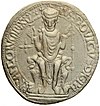 |
Louis VI the Fat | 29 July 1108 | 1 August 1137 | • Son of Philip I | ||
 |
Louis VII the Young | 1 August 1137 | 18 September 1180 | • Son of Louis VI | ||
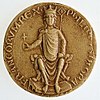 |
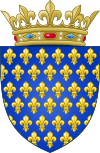 |
Philip II Augustus (Philippe Auguste) |
18 September 1180 | 14 July 1223 | • Son of Louis VII | King of the Franks (Roi des Francs) King of France (Roi de France) |
 |
 |
Louis VIII the Lion | 14 July 1223 | 8 November 1226 | • Son of Philip II Augustus | King of France (Roi de France) |
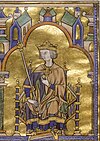 |
 |
Louis IX the Saint (Saint Louis) |
8 November 1226 | 25 August 1270 | • Son of Louis VIII | |
 |
 |
Philip III the Bold (Philippe) |
25 August 1270 | 5 October 1285 | • Son of Louis IX | |
 |
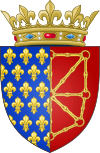 |
Philip IV the Fair, the Iron King (Philippe) |
5 October 1285 | 29 November 1314 | • Son of Philip III | King of France and of Navarre (Roi de France et de Navarre) |
 |
 |
Louis X the Quarreller | 29 November 1314 | 5 June 1316 | • Son of Philip IV | |
 |
 |
John I the Posthumous (Jean) |
15 November 1316 | 20 November 1316 | • Son of Louis X | |
 |
 |
Philip V the Tall (Philippe) |
20 November 1316 | 3 January 1322 | • Son of Philip IV • Younger brother of Louis X | |
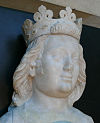 |
 |
Charles IV the Fair | 3 January 1322 | 1 February 1328 | • Son of Philip IV • Younger brother of Louis X and Philip V |
House of Valois (1328–1589)
[سودھو]The death of Charles IV started the Hundred Years' War between the House of Valois and the House of Plantagenet later the House of Lancaster over control of the French throne.[۸] The Valois claimed the right to the succession by male-only primogeniture, having the closest all-male line of descent from a recent French king. They were descended from the third son of Philip III, Charles, Count of Valois. The Plantagenets based their claim on being closer to a more recent French king, Edward III of England being a grandson of Philip IV through his mother, Isabella. The two houses fought the Hundred Years War to enforce their claims; the Valois were ultimately successful, and French historiography counts their leaders as rightful kings. One Plantagenet, Henry VI of England, did enjoy de jure control of the French throne under the terms of the Treaty of Troyes, which formed the basis for continued English claims to the throne of France until 1801. The Valois line would rule France until the line became extinct in 1589, in the backdrop of the French Wars of Religion. As Navarre did not have a tradition of male-only primogeniture, the Navarrese monarchy became distinct from the French, with Joan II, a daughter of Louis X, inheriting there.
| Portrait | Coat of arms | Name | King from | King until | Relationship with predecessor(s) | Title |
|---|---|---|---|---|---|---|
 |
 |
Philip VI the Fortunate (Philippe) |
1 April 1328 | 22 August 1350 | • Grandson of Philip III of France | King of France (Roi de France) |
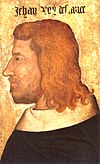 |
 |
John II the Good (Jean) |
22 August 1350 | 8 April 1364 | • Son of Philip VI | King of France (Roi de France) |
 |
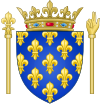 |
Charles V the Wise | 8 April 1364 | 16 September 1380 | • Son of John II | King of France (Roi de France) |
 |
 |
Charles VI the Beloved, the Mad | 16 September 1380 | 21 October 1422 | • Son of Charles V | King of France (Roi de France) |
House of Lancaster (1422–1453)
[سودھو]- ہور ویکھو: English claims to the French throne
From 1340 to 1360 and from 1369 to 1801 the Kings of England and Great Britain claimed the title of King of France. Under the terms of the 1420 Treaty of Troyes, Charles VI had recognized his son-in-law Henry V of England as regent and heir. Henry V predeceased Charles VI and so Henry V's son, Henry VI, succeeded his grandfather Charles VI as King of France. Most of Northern France was under English control until 1435 but by 1453 the English had been expelled from all of France save Calais and the Channel Islands. Calais itself fell in 1558. Nevertheless, English and then British monarchs continued to claim the title for themselves until the creation of the United Kingdom in 1801.
| Portrait | Coat of arms | Name | King from | King until | Claim | Title |
|---|---|---|---|---|---|---|
 |
 |
Henry VI of England (Henri VI d'Angleterre) |
21 October 1422 | 19 October 1453 | By right of his father Henry V of England, who by conquest forced the French to sign the Treaty of Troyes became heir and regent of France. Grandson of Charles VI of France. | King of France (Roi de France) |
House of Valois (1328–1589)
[سودھو]| Portrait | Coat of arms | Name | King from | King until | Relationship with predecessor | Title |
|---|---|---|---|---|---|---|
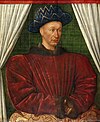 |
 |
Charles VII the Victorious, the Well-Served |
21 October 1422 | 22 July 1461 | • Son of Charles VI • Uncle of Henry VI of England |
King of France. (Roi de France) |
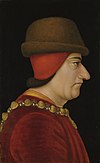 |
 |
Louis XI the Prudent, the Cunning, the Universal Spider | 22 July 1461 | 30 August 1483 | • Son of Charles VII | King of France (Roi de France) |
 |
 |
Charles VIII the Affable | 30 August 1483 | 7 April 1498 | • Son of Louis XI | King of France (Roi de France) |
 |
 |
Louis XII Father of the People |
7 April 1498 | 1 January 1515 | • Great-grandson of Charles V • Second cousin, and by first marriage son-in-law of Louis XI • Also Second cousin once removed to Charles VIII. |
King of France (Roi de France) |
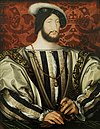 |
 |
Francis I the Father and Restorer of Letters (François) |
1 January 1515 | 31 March 1547 | • Great-great-grandson of Charles V • First cousin once removed, and by first marriage son-in-law of Louis XII |
King of France (Roi de France) |
 |
 |
Henry II (Henri) |
31 March 1547 | 10 July 1559 | • Son of Francis I • Maternal grandson of Louis XII |
King of France (Roi de France) |
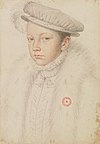 |
 |
Francis II (François) |
10 July 1559 | 5 December 1560 | • Son of Henry II | King of France (Roi de France) King Consort of Scotland (1558–1560) through marriage to Mary, Queen of Scots (1542–1567) |
 |
 |
Charles IX | 5 December 1560 | 30 May 1574 | • Son of Henry II | King of France (Roi de France) |
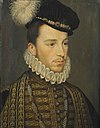 |
 |
Henry III (Henri) |
30 May 1574 | 2 August 1589 | • Son of Henry II | King of France (Roi de France) King of Poland and Grand Duke of Lithuania (1573–1575) |
House of Bourbon (1589–1792)
[سودھو]The Valois line looked strong on the death of Henry II, who left four male heirs. His first son, Francis II, died in his minority. His second son, Charles IX, had no legitimate sons to inherit. Following the assassination of his third son, the childless Henry III, and the premature death of his fourth son Hercule François, France was plunged into a succession crisis over which distant cousin of the king would inherit the throne. The best claimant, King Henry III of Navarre, was a Protestant, and thus unacceptable to much of the French nobility. Ultimately, after winning numerous battles in defence of his claim, Henry converted to Catholicism and was crowned as king Henry IV, founding the House of Bourbon. This marked the second time the thrones of Navarre and France were united under one monarch; as different inheritance laws had caused them to become separated during the events of the Hundred Years Wars. The House of Bourbon would be overthrown during the French Revolution and replaced by a short-lived republic.
| Portrait | Coat of arms | Name | King from | King until | Relationship with predecessor(s) | Title |
|---|---|---|---|---|---|---|
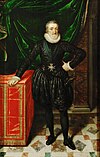 |
 |
Henry IV the Green Gallant Good King Henry (Henri) |
2 August 1589 | 14 May 1610 | • Tenth generation descendant of Louis IX in the male line • By first marriage son in law of Henry II, Brother in law of Francis II, Charles IX and Henry III • Great-great-great grandson of Charles VII |
King of France and of Navarre (Roi de France et de Navarre) |
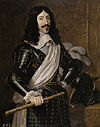 |
 |
Louis XIII the Just | 14 May 1610 | 14 May 1643 | • Son of Henry IV | King of France and of Navarre (Roi de France et de Navarre) |
 |
 |
Louis XIV the Great the Sun King | 14 May 1643 | 1 September 1715 | • Son of Louis XIII | King of France and of Navarre (Roi de France et de Navarre) |
 |
 |
Louis XV the Beloved |
1 September 1715 | 10 May 1774 | • Great-grandson of Louis XIV | King of France and of Navarre (Roi de France et de Navarre) |
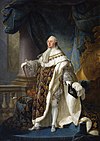 |
 |
Louis XVI | 10 May 1774 | 21 September 1792 | • Grandson of Louis XV | King of France and of Navarre (Roi de France et de Navarre) (1774–1791) King of the French (Roi des Français) (1791–1792) |
 |
 |
Louis XVII (Claimant) |
21 January 1793 | 8 June 1795 | • Son of Louis XVI | (Disputed) King of France and of Navarre (Roi de France et de Navarre) |
House of Bonaparte, First Empire (1804–1814)
[سودھو]The French First Republic lasted from 1792 to 1804, after which its popular First Consul, Napoléon Bonaparte, decided to make France a monarchy again. He took the popular title Emperor of the French instead of King of France and Navarre or King of the French to avoid all titles of the Kingdom of France making France's second popular monarchy.
| Portrait | Coat of arms | Name | Emperor from | Emperor until | Relationship with predecessor(s) | Title |
|---|---|---|---|---|---|---|
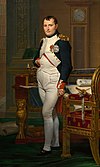 |
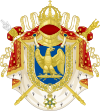 |
Napoleon I (Napoléon) |
18 May 1804 | 11 April 1814 |
|
Emperor of the French (Empereur des Français) |
Capetian Dynasty (1814–1815)
[سودھو]Following the first defeat of Napoleon and his exile to Elba, the Bourbon monarchy was restored, with Louis XVI's younger brother Louis Stanislas being crowned as Louis XVIII. Louis XVI's son had been considered by monarchists as Louis XVII but he was never crowned and never ruled in his own right before his own death. He is not usually counted among French monarchs, creating a gap in numbering on most traditional lists of French kings. Napoleon would briefly regain control of the country during his Hundred Days rule in 1815. After his final defeat at the Battle of Waterloo, Napoleon attempted to abdicate in favour of his son but the Bourbon Monarchy was re-established yet again and would continue to rule France until the July Revolution of 1830, replaced it with a cadet branch, the House of Orleans.
House of Bourbon, Bourbon Restoration (1814–1815)
[سودھو]| Portrait | Coat of arms | Name | King from | King until | Relationship with predecessor(s) | Title |
|---|---|---|---|---|---|---|
 |
 |
Louis XVIII the Desired | 11 April 1814 | 20 March 1815 | • Grandson of Louis XV • Younger Brother of Louis XVI |
King of France and of Navarre (Roi de France et de Navarre) |
House of Bonaparte, First Empire (Hundred Days, 1815)
[سودھو]| Portrait | Coat of arms | Name | Emperor from | Emperor until | Relationship with predecessor(s) | Title |
|---|---|---|---|---|---|---|
 |
 |
Napoleon I (Napoléon) |
20 March 1815 | 22 June 1815 | • Founder of the Bonaparte dynasty | Emperor of the French (Empereur des Français) |
 |
 |
Napoleon II the Eaglet (Napoléon) [lower-alpha ۲] |
22 June 1815 | 7 July 1815 | • Son of Napoleon I | (Disputed) Emperor of the French (Empereur des Français) |
Capetian dynasty (1815–1848)
[سودھو]House of Bourbon (1815–1830)
[سودھو]| Portrait | Coat of arms | Name | King from | King until | Relationship with predecessor(s) | Title |
|---|---|---|---|---|---|---|
 |
 |
Louis XVIII the Desired | 7 July 1815 | 16 September 1824 | • Grandson of Louis XV • Younger Brother of Louis XVI |
King of France and of Navarre (Roi de France et de Navarre) |
 |
 |
Charles X | 16 September 1824 | 2 August 1830 | • Grandson of Louis XV • Younger Brother of Louis XVI and Louis XVIII |
King of France and of Navarre (Roi de France et de Navarre) |
 |
 |
Louis XIX Antoine | 2 August 1830 | 2 August 1830 (20 minutes) |
• Son of Charles X | (Disputed) King of France and of Navarre (Roi de France et de Navarre) |
 |
 |
Henry V (Henri) |
2 August 1830 | 9 August 1830 (7 days) |
• Grandson of Charles X • Nephew of Louis Antoine |
(Disputed) King of France and of Navarre (Roi de France et de Navarre) |
The Bourbon Restoration came to an end with the July Revolution of 1830 which deposed Charles X and replaced him with Louis Philippe I, a distant cousin with more liberal politics. Charles X's son Louis signed a document renouncing his own right to the throne only after a 20-minute argument with his father. Because he was never crowned he is disputed as a genuine king of France.[۹] Louis's nephew Henry was likewise considered by some to be Henry V but the new regime did not recognise his claim and he never ruled.
House of Orléans, July Monarchy (1830–1848)
[سودھو]Under Louis Philippe, the popular monarchy of France changed the styles and forms of the ancien régime, replacing them with more populist forms like replacing "King of France" with "King of the French").
| Portrait | Coat of arms | Name | King from | King until | Relationship with predecessor(s) | Title |
|---|---|---|---|---|---|---|
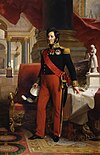 |
 |
Louis Philippe I the Citizen King | 9 August 1830 | 24 February 1848 | • Sixth generation descendant of Louis XIII in the male line • Fifth cousin of Louis XVI, Louis XVIII and Charles X |
King of the French (Roi des Français) |
 |
 |
Louis-Philippe II or Philippe VII |
24 February 1848 | 26 February 1848 (2 days) |
• Grandson of Louis Philippe I | (Disputed) King of the French (Roi des Français) |
Over the years Louis Philippe grew more conservative. When a revolution broke out he fled to Great Britain leaving his grandson Prince Philippe, Count of Paris as King of the French. Two days later the Second French Republic was declared. He was never proclaimed, making him disputed as a genuine monarch.[حوالہ درکار]
House of Bonaparte, Second Empire (1852–1870)
[سودھو]The French Second Republic lasted from 1848 to 1852, when its president, Louis-Napoléon Bonaparte, was declared Emperor of the French. He took the regnal name of Napoleon III after his uncle (Napoleon I) and his cousin (Napoleon II, who was declared but uncrowned as heir to the Imperial throne).
Napoleon III would later be overthrown during the events of the Franco-Prussian War. He was the last monarch to rule France. After that the country was ruled by a succession of republican governments (see French Third Republic).
| Portrait | Coat of arms | Name | Emperor from | Emperor until | Relationship with predecessor(s) | Title |
|---|---|---|---|---|---|---|
 |
 |
Napoleon III (Napoléon) |
2 December 1852 | 4 September 1870 | • Nephew of Napoleon I | Emperor of the French (Empereur des Français) |
Later pretenders
[سودھو]Various pretenders descended from the preceding monarchs have claimed to be the legitimate monarch of France, rejecting the claims of the president of France, and of each other. These groups are:
- Legitimist claimants to the throne of France: descendants of the Bourbons, rejecting all heads of state 1792–1814, 1815, and since 1830. Unionists recognized the Orléanist claimant after 1883.
- Legitimist-Anjou claimants to the throne of France: descendants of Louis XIV, claiming precedence over the House of Orléans by virtue of primogeniture.
- Orléanist claimants to the throne of France: descendants of Louis-Phillippe, himself descended from a junior line of the Bourbon dynasty, rejecting all heads of state since 1848.
- Bonapartist claimants to the throne of France: descendants of Napoleon I and his brothers, rejecting all heads of state 1815–48, and since 1870.
- English claimants to the throne of France: kings of England and later, of Great Britain (renounced by Hanoverian King George III upon union with Ireland in 1800).
- Jacobite claimants to the throne of France: senior heirs-general of King Edward III of England and thus his claim to the French throne, also claiming England, Scotland, and Ireland.
Timeline
[سودھو]
ہور ویکھو
[سودھو]- Kings of France family tree (detailed)
- French monarchs family tree (simple)
- Style of the French sovereign
- English claims to the French throne
- List of French consorts
- List of heirs to the French throne
نوٹس
[سودھو]- ↑ 'Louis XII, 1499 [...] LVDOVIVS XII FRANCORUM REX MEDILANI DUX [...] Francis I, 1515 [...] FRANCISCUS REX FRANCORUM PRIMUS DOMINATOR ELVETIORUM [...] Henri II, 1550? [...] HENRICVS II FRANCORVM REX' [۲]
- ↑ From 22 June to 7 July 1815, Bonapartists considered Napoleon II as the legitimate heir to the throne, his father having abdicated in his favor. However, throughout this period he resided in Austria, with his mother. Louis XVIII was reinstalled as king on 7 July.
حوالے
[سودھو]- ↑ ۱.۰ ۱.۱ (2006) Mystifying the Monarch: Studies on Discourse, Power, and History. Amsterdam, Netherlands: Amsterdam University Press, 182. ISBN 9789053567678.
- ↑ Potter, David (2008). Renaissance France at War: Armies, Culture and Society, c.1480–1560, Warfare in History Series 28. Boydell & Brewer Ltd, viii. ISBN 9781843834052.
- ↑ (1806) Le Couronnement de Napoléon Premier, Empereur des Français. Paris, France: Guerin, 1.
- ↑ Pascal, Adrien (1853). Histoire de Napoléon III, Empereur des Français. Paris, France: Barbier, 359.
- ↑ Babcock, Philip (1993). Webster's Third New International Dictionary of the English Language, Unabridged. MA, USA: Merriam-Webster, 341.
- ↑ Gwatking, H. M. (1930). Cambridge Medieval History: Germany and the Western Empire Volume III. London: Cambridge University Press.
- ↑ Parisse, Michael (2005). "Lotharingia", The New Cambridge Medieval History: c. 900–c. 1024 III. Cambridge, UK: Cambridge University Press, 313–315.
- ↑ Knecht, Robert (2004). The Valois: Kings of France 1328–1422. NY, USA: Hambledon Continuum, ix–xii. ISBN 1852854200.
- ↑ Lua error in ماڈیول:Citation/CS1/Date_validation/ar at line 45: attempt to compare number with nil.
کتابیات
[سودھو]- (1967) Kings, Rulers, and Statesmen. NY, USA: Sterling Publishing Co., Inc., 103–107.سانچہ:Unreliable source?
